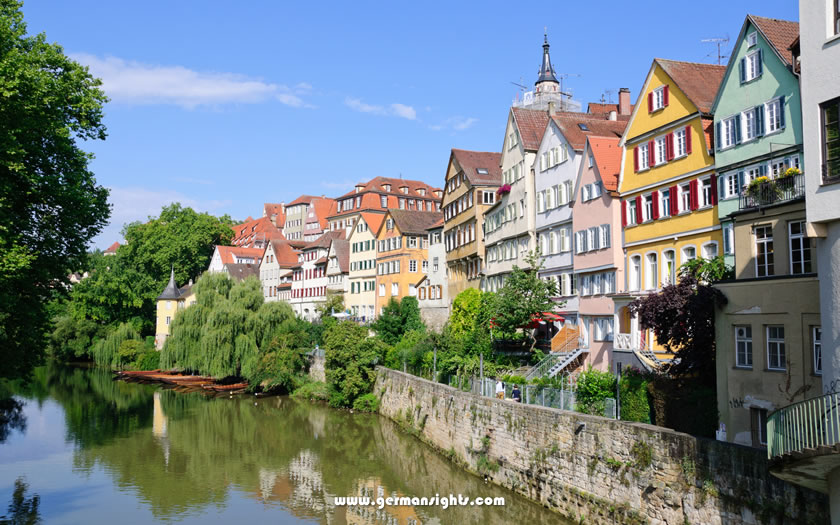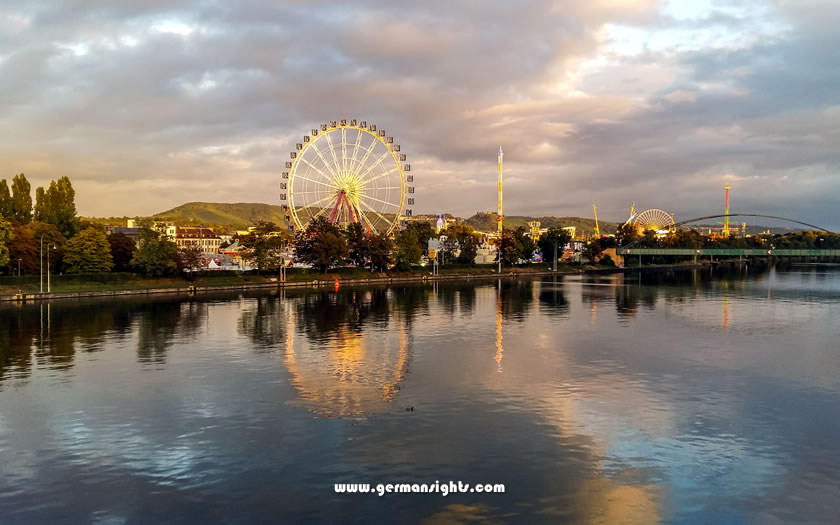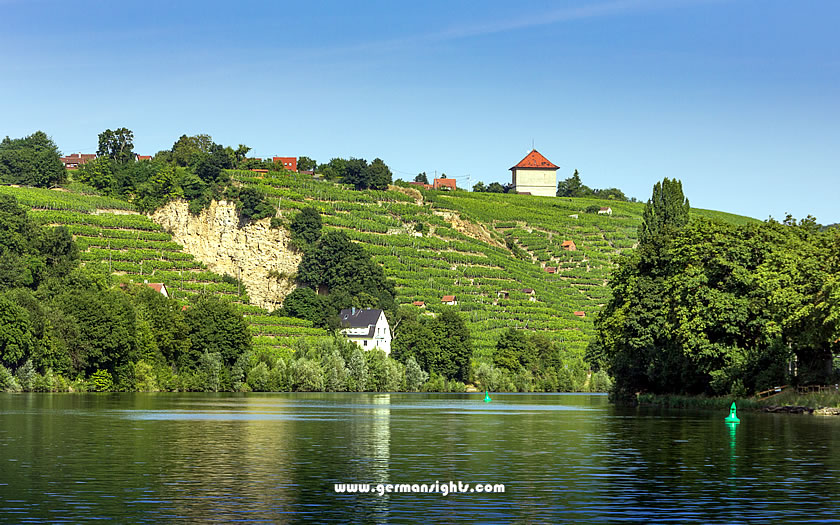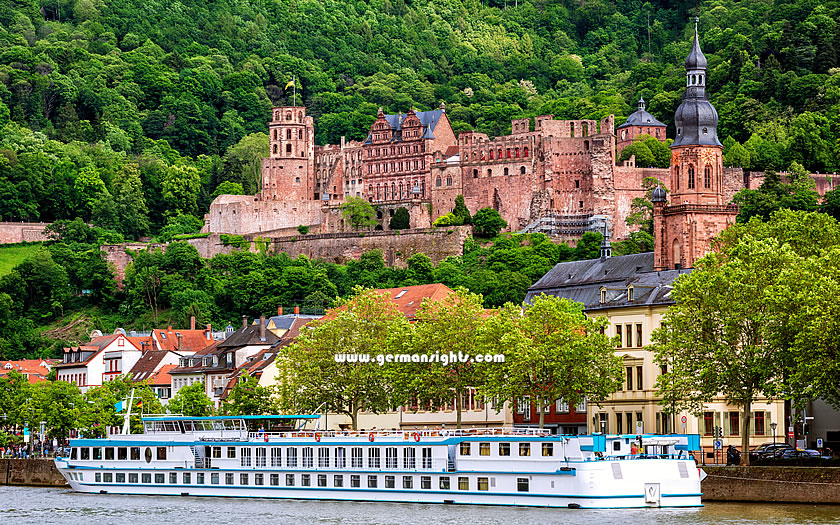The Neckar is a 362 kilometre long river that flows through the south-western part of Germany.
It rises in the Schwarzwald-Baar district near Schwenningen at an elevation of 706 metres and eventually joins the Rhine river at Mannheim.
There are many historic towns and cities along the river Neckar. The banks of the river are also an important part of the winemaking industry in Germany, especially in the Swabian Alb area where it passes through Tübingen and other scenic towns.

View of the historic houses along the river Neckar in Tübingen
The Neckar is more than just a beautiful river with a few attractive vineyards on its banks. It is an important economic factor for the region's towns and villages.
The river has been used for trade and power generation for centuries. Exploring the Neckar river is a rewarding way to learn more about the heritage of this part of south-west Germany.
The Neckar River flows through southwestern Germany, mainly in Baden-Württemberg, with a short section through Hesse.
Along the Neckar Valley, some cities and municipalities have thrived for centuries, offering a glimpse into the captivating history of this region.
One such city is Tübingen, home to the Eberhard Karls University, established in 1477. As you delve into the Middle Ages, you'll discover how significant the river has been as a source of transportation, trade, and sustenance for those living along its banks.

The Neckar in Bad Canstatt near Stuttgart
Stuttgart, the capital and largest city of Baden-Württemberg, is on the Neckar river. The city became a centre of textile production, engineering and railway construction in the 19th century. Stuttgart emerged as a leading centre for car manufacturers in the following century.
The river Neckar played an important role in the industrial growth of Stuttgart, providing water supply, transportation and power generation. The Neckar also shaped the urban landscape of Stuttgart, with many bridges, parks and cultural venues along its banks.
Heidelberg lies on the east bank of the river, which served as a vital transportation route for trade and travel as the town developed.
The city was built at the point where the Neckar leaves its narrow valley through the Odenwald hills and enters the wide plain towards Mannheim.
Heidelberg Castle offers fabulous views of the river traffic on the river and the historic Alte Brücke allows visitors to enjoy the views from both sides.
Taking a boat ride along the Neckar is a popular way to explore Heidelberg and see the city from a different perspective.
Boat tours typically depart from the Old Bridge or from nearby towns like Neckarsteinach.
The landscape of the Neckar Valley changes as the river flows from its source in the Swabian Jura to where it joins the Rhine.
At its source, the Neckar runs through steep valleys and gorges with lush forests and small waterfalls. As it flows northward towards Stuttgart, the valley opens up into rolling hills dotted with vineyards, orchards, and meadows.
The Neckar brushes the edges of the Odenwald Hills before reaching Heidelberg. The landscape along the Neckar river between Heidelberg and Mannheim is characterized by its broad floodplains, woods and meadows. This section of the river is relatively flat compared to the more hilly areas further south.

Vineyards along the Neckar near Stuttgart
One must-see feature of the Neckar Valley is its many vineyards. The region is renowned for producing high-quality wines such as Riesling and Trollinger.
The climate in the Neckar Valley is continental, with warm summers and cool winters.
Summer temperatures are quite mild and typically range from 20°C to 30°C.
The winter months are cold but rarely extreme, with temperatures averaging between -2°C and 7°C. Snowfall is relatively common in the hillier areas of the valley during winter.
Nature lovers will appreciate the diverse flora and fauna found throughout the Neckar Valley. The valley’s forests are home to deer, wild boars, foxes, and badgers.
The River Neckar has a rich history of navigation dating back to ancient times. However, it wasn't until the 20th century that the river was fully canalised and made navigable for larger vessels.
Today, the Neckar is an important waterway linking industrial centres such as Stuttgart and Heilbronn to the Rhine and beyond.
The river is a hub for transport, trade and tourism - all at the same time! The river is home to several ports that act as centres of commerce, logistics and cultural experiences.
There's always something going on on this active river. Whether you're enjoying a relaxing cruise on its tranquil waters or witnessing large barges transporting goods from one place to another.

River ferry on the Neckar in Heidelberg
But what really makes this river special are the picturesque buildings on both sides of the waterway. Castles perched on hillsides will take you back in time, while palaces showcase opulent architecture that hints at the royalty of the past - just like in Heidelberg, where you can explore the iconic Heidelberg Castle that towers over the old town below.
River cruises are available on the Neckar and offer visitors a unique experience to see some of the region's most beautiful sights from a different perspective. There are several options for river cruising along the Neckar, each with its own charm.
One popular option is a round trip cruise from Heidelberg. This type of river cruise typically lasts around 50 minutes and takes visitors up and down the river, offering stunning views of the city's iconic landmarks such as Heidelberg Castle, the Old Bridge and the Philosopher's Walk.
Another popular option is to take a day trip on one of the many boats that offer more extensive tours up and down the Neckar. These tours usually last between 4-5 hours and give passengers an excellent view of the changing scenery.
Several tour operators offer boat trips from Heilbronn that take visitors through the picturesque vineyards of Neckarsulm and Bad Wimpfen before returning to Heilbronn.
Famous for its stunning sunsets and many picturesque locations, the Neckar offers a wealth of inspiration for those seeking artistic inspiration.
Over the years, the river has found its way into various forms of art, including paintings, poetry and novels.
One notable example is the work of Mark Twain, who wrote about his travels along the Neckar in "A Tramp Abroad". In this famous work, Twain recounts his experiences on a raft travelling from Heilbronn to Heidelberg.
Many artists have used the peaceful atmosphere of the Neckar to create engaging and enchanting works.
One of them was Carl Blechen, a German Romantic painter famous for his landscapes.
Blechen painted several scenes along the Neckar during his travels through Germany in the early 19th century. His painting 'View of Heidelberg Castle and City' depicts a stunning view of the ruins of Heidelberg Castle, perched on a hill overlooking the river valley below.
Another artist who painted scenes in the Neckar region was Ernst Ludwig Kirchner, a German expressionist painter. Kirchner was drawn to the area by its natural beauty and spent time in towns such as Bad Wimpfen and Neckarsulm, painting scenes of local life as well as landscapes.